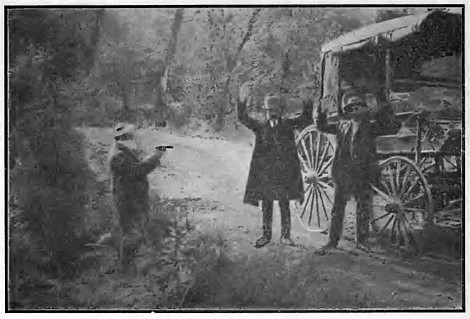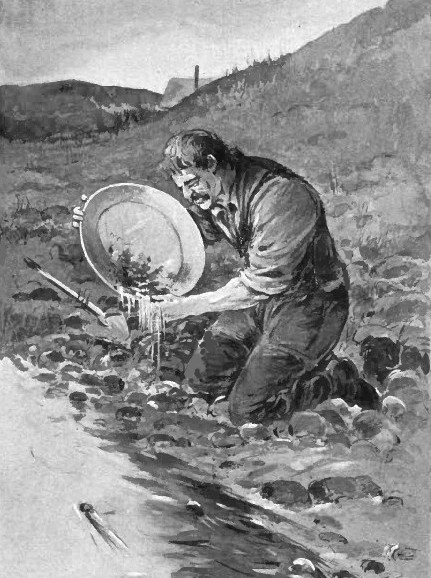On the 25th day of April, 1876, in a wild and picturesque gorge, nearly five thousand feet above sea level, the town of Deadwood was laid out, at the junction of Whitewood and Deadwood Creeks. Some parties claim that a man named "Fyler" was instrumental in laying out the embryo city. Others say that Craven Lee, Isaac Brown, Noah Seiver, James Hamilton, E. Durham, Charles Barber, J. J. Williams and "Red" Young laid out the town, using a lariat rope instead of a surveyor's chain for a measure. However, the town was laid out, and the first house, a pine-log cabin, was built by Lee and Brown, about the first of May, and by the middle of June the place had grown into a bustling town. At that time the buildings were of the poorest character, nothing, in fact, but tents and log cabins; even the stores and business places were of the same kind. Everything bore the aspect of a mere camp in the woods. Stumps and trees blocked the streets in every direction; a forest had just previously covered the site. Gradually the timber disappeared, and by the first of July three steam saw-mills were turning out about twenty thousand feet of lumber daily, and were not sufficient to supply the demand for building and mining purposes. Every industry seemed to prosper. Merchants who went there in 1876 and early in 1877, taking with them stocks of goods, disposed of them at fabulous prices. One man took into the place in his own wagons goods which he bought in Cheyenne for three thousand dollars, and sold them as fast as he could open them from the boxes, receiving for them about ten thousand dollars.
The village of 1876 grew into a town in 1877, and a rushing city in 1879. Handsome public and private buildings were erected on every hand; five hundred shops and mercantile houses, some of them carrying from twenty-five to fifty thousand dollars* worth of goods, were scarcely sufficient at this time to do the business of the place. There were three daily papers, three banks, hotels and restaurants almost without number, three theatres, four churches, and a fine graded school-house. On September 25th, 1879, Deadwood had put on metropolitan airs, and boasted of over five thou sand inhabitants. By the next day the fire-fiend had leveled it to the ground.
The Great Fire.
About half-past one o'clock, on the morning of September 26th, a fire
broke out in a bakery on Sherman Street. The building and those adjoining it
were of the most inflammable character wooden buildings, made of yellow
pine. The wind blew a gale, and sparks flew in showers, setting fire to
everything they touched. The flames roared through the business portion, and
on to the private residences along the hillsides, sparing nothing in its
course. The startled citizens had barely time to escape with their lives,
many of them saving only the scanty clothing which they caught up as they
fled. The blowing up of some houses with giant powder stopped the fire's
devastating career at China Town, and the tearing down of other buildings at
the intersection of Pine and Sherman Streets checked it there. But it was
too late. From the corner of Pine and Sherman Streets to China Town, an area
of nearly half a mile long by a quarter wide, every house, whether brick or
frame, with the exception of about a dozen small fireproofs, was gone. In
three hours from the time the fire began there was not a dry-goods, grocery,
or boot and shoe store ; not a hotel, theatre, bank or printing-office left
in what had been the main business part of Deadwood. The destruction was
complete and the loss total. Nearly three hundred buildings and their
contents were swept away, and daylight dawned upon two thousand houseless
and homeless people, perching around half naked on the bleak mountain crags,
with heaps of ashes and cinders as their only possessions on earth. Thus, in
an incredible short space of time, over one and a half million dollars worth
of property was destroyed, on which there was scarcely any insurance.
But, phoenix-like, the ruined city, in a few short months, as if by magic, has arisen from its ashes. It is said that merchants, while their buildings were still in flames on that memorable morning, were galloping out before daylight. to the saw-mills to order lumber and materials for building, and that the foundations of new structures were lain while the stones were still hot from the effects of the fire. A month later a Deadwood paper stated: "The whole place is a teeming hive of human bees without a drone. The streets are blockaded with wagons, teams, lumber, brick, mortar and throngs of sturdy laborers. Every man you meet has his coat off and working tools in his hands. The whole air is filled with the clatter of hammers and saws. Men with lanterns swinging on the dirt banks beside them, dig away all night long on excavations for cellars and foundations ; and carpenters, with miners' lamps on their hat-fronts, nail on boards and laths and shingles at midnight as busily as noonday. Sundays, as well as week days, the din and rush go on without ceasing. The whole population exchanging, lending and helping each other; law-offices in bar-rooms, courts held in shanties, and newspapers interchanging type, labor and material. Amid all the loss and desolation there has been no wrangling about titles, though every record was destroyed, and possession is almost the sole evidence of proprietorship; no disorder, no whining, no sign of discouragement. And to-day Deadwood, nearly rebuilt, stands forth the cheeriest, pluckiest little city in all Christendom."
Deadwood Rebuilt.
By six months time afterward but very few traces of the great fire
remained. The new town which had arisen was an improvement on the old one,
the buildings are larger, finer and better made, and business has in every
way resumed its natural channels. To give an idea of the vast transactions
going on in this little mountain city: As early as 1877 one bank did a
business of from twenty-five to seventy-five thousand dollars per day, in
buying
gold nuggets and selling exchange, and one hotel at this time
fed as many as one thousand people inside of twenty-four hours ; single
firms were selling goods to the amount of from seven to ten thou sand
dollars per month. This business, of course, became divided up later, as the
town filled up and competition became greater, but on the whole, the trade
of the city largely increased. Deadwood is now the distributing point for
many outlying
towns and mining camps, and of the twenty million pounds of freight which
arrived in the Black Hills during 1879, probably over two thirds of it came
to Deadwood, and was distributed from there.
Deadwood is situated in the heart of the greatest mineral region of the world, proudly bearing the title of Metropolis of the Hills,' draining the trade as the water shed of every one of the important gold ore mining camps of the Black Hills, it is to the development of the mining resources of the Hills, that the city must look for future prosperity. The two stage routes, the one from Pierre, the other from Sidney to Deadwood, furnished an unlimited amount of material for the romancer. Hardly a day passed in early days without the report that the state had been robbed. It was especially the outgoing treasury coach with the gold bullion from the mines, for which the "road agents" laid in wait. The bullion at first was carried in a safe made of chilled steel, but after repeated robberies the celebrated " Deadwood Coach " was made for this purpose. This was a formidable affair. A regular heavy six-horse coach, lined all over with steel and looking almost like a man-of-war on wheels.
Return
to The South Dakota Page:
South Dakota Gold Rush History



